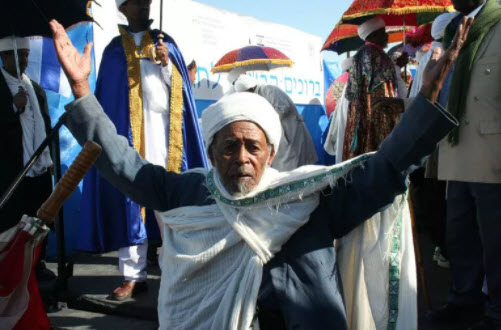Rabbi Sharon Shalom, the Director of the International Center for the Study of Ethiopian Jewry at Ono Academic College notes that in many ways, the Passover described in the bible is different from the way Passover was celebrated in practice, according to the Talmud. In fact, the closest way to experience the biblical type of Passover celebration is through the religious life of Ethiopian Jews, who were anchored in the spirit of the biblical literature and biblical practice. In other words, the encounter between Israeli Jews and Jews of Ethiopian descent is not only an encounter between new and old immigrants, but also an encounter between two models of Judaism, biblical and Rabbinic. It seems that Passover adequately demonstrates the difference between the biblical model and the Talmudic model.
Rabbi Sharon remembers that in one of the demonstrations of Ethiopians against discrimination and racism, a man approached him saying, “I do not understand at all the meaning of the demonstration! For in light of the village life you had in Ethiopia; a straw house, no running water, no sewer and electricity system, the reception you are receiving in Israel in an absorption center with trailer housing is still a huge technological leap forward. It’s an improvement in the quality of life!”
Rabbi Sharon noted he did not know what to say and asked for time to think. After a few days I presented this question to Mr. David Mahart He replied, “The man is right. Immigration from Ethiopia to Israel has led to an increase in the standard of living, but this man is not smart enough to understand that the increase in the standard of living has severely affected the quality of life.”
Most Ethiopian Jews lived in small communities in the villages, and a minority lived in the cities. The technological standard of living and urban life were foreign to them, but the quality of life was high. The knowledge acquired helped them feel comfortable regarding their family life and earning a living. Their livelihood was based on agriculture, grazing and blacksmithing. The women worked in the household and raised the children as is customary in traditional societies. Immigration to Israel, on the one hand, led to an increase in the technological standard of living, but on the other, it harmed their quality of life. The move to Israel upset the balance.
It seems that the distinction between “quality of life” and “standard of living” opens deep questions regarding the contrasts between the life of modern man in general and the life of the person who follows halakhah (Jewish law). That is, the division between the quality of life and the standard of living teaches what freedom is. True freedom is not necessarily achieved by lack of bondage, and a life of well-being. Quality of life does not depend on circumstances. One must distinguish between a high “standard of living” reflected in a large bank account, a luxury car and a large house, and the “quality of life” which is the ability to live a life of peace and self-confidence while controlling what is happening. This is the way I think that in the field of faith and religion there is a possibility to distinguish between the “level of faith” and the “quality of faith”. Moreover, a similar division can also be found in the field of law. One the one hand, the multiplicity of laws should indicate a moral and democratic society. However, on the other hand, the multiplicity of laws indicates, paradoxically, that society has lost its natural morality and now it needs external laws and restrictions.
This dynamic allows us to better understand the differences between the biblical Passover and the Talmudic Passover. The biblical Pesach emphasizes the experience and the Talmudic Pesach emphasizes the mitzvah (commandment). Rabbi Sharon remembers that in Ethiopia, the Passover holiday was celebrated mostly with great fanfare in the courtyard of the village synagogue, while offering animal sacrifices and telling stories of the Exodus from Egypt. There was no Passover Haggadah; we did not keep looking at our watch to know when to end the ceremony – before midnight or after midnight. We celebrated the biblical Passover. It is an unforgettable experience.
Talmudic Passover to some extent emphasizes the halakhah and the obligation to keep the mitzvah; It focuses on who has an obligation and who is exempt, how to eat, what to eat and how much to eat. In short, it can be argued that in Ethiopia they made an experience out of the holiday chaos and in Israel they make order out of the holiday chaos. Rabbi Soloveitchik explains: “Halacha emphasizes deeds more than experiences, because it is assured that the deeds can arouse the soul, ignite the imagination and move the heart” (Man and His Home, pp. 63-64).
Both of these approachesd are the words of a living God. However, the obligation to keep the mitzvah may impair the consciousness of morality. That is to say, the worries we have that the Seder night that will pass properly will necessarily impair the experience of the natural flow. Passover is thus a symbol of a reality in which chametz (leavened food) and matzah are made from one flour element. We want to connect “standard of living” with “quality of life”. Behind the “Russian”, the “Ethiopian”, the “secular”, the “Ashkenazi”, the “Sephardi”, the “Haredi”, etc. – there is a person – a valuable individual person. Alongside the pursuit of improving the standard of living (chametz), care must be taken not to detach oneself from the quality of life (matzah), from the “authenticity” and experience. For as we read in the Seder’s four questions, “On every other night we eat chametz and matzah. Tonight it we eat only matzah.*
The full article can be read at https://shabaton1.co.il/?p=18937
